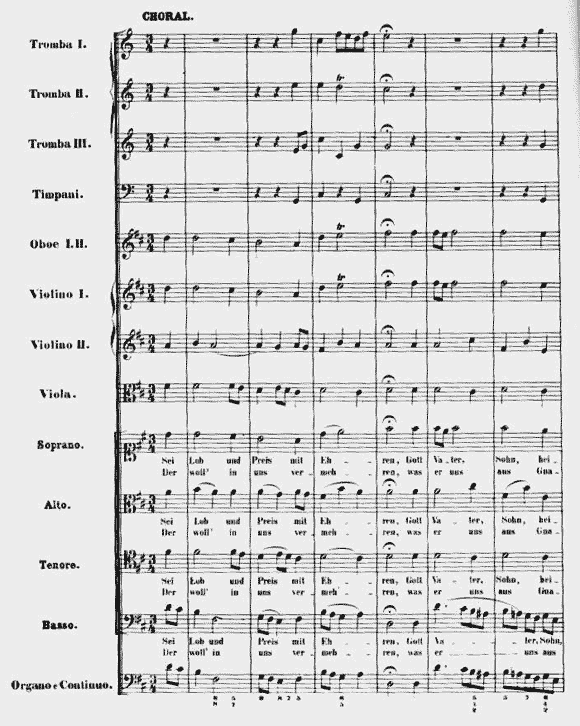Although there is a reference to “Gott” is in the title, this is not actually a “church cantata” – that is, it was not written for a specific liturgical feast. But the work is a sacred cantata, written for a church service accompanying the installation of the Leipzig town council in 1731 (premiered August 27); Cantata 29 was also performed in 1739 and 1749 in Leipzig.
This work is one of at least six written by Bach for church services accompanying elections and installations of public officials in Leipzig city (David Schulenberg, in Oxford Composer Companions: J.S. Bach); all use trumpets, timpani, oboes, strings, and continuo: the big ensemble reflects the importance of the occasions, and adds “pomp and circumstance”. The author of the text is unknown, except for the final chorale (the fifth stanza of Gramann’s chorale “Nun lob, mein Seel, den Herren”).
The opening movement (sinfonia) will have a familiar sound to listeners who do not already know this cantata: it is an arrangement of the Prelude from the Partita in E major for unaccompanied violin:

The treble of the obbligato organ part plays the famous partita tune, transposed here from E major down a step to D major. Bach adds trumpet and drum parts here for punctuation, and to make the opening line even more festive than the mood created by the partita theme alone. String and oboe parts provide additional reinforcement. It is unusual to find an obbligato organ part – more importantly, an independent organ part which is separate from the continuo. Was this a showcase for Bach’s own organ virtuosity? Or did Bach serve as a conductor here for the larger than usual cantata ensemble, while someone else – one of his talented sons? – stood at the organ?
The second movement, likewise, will sound familiar, especially to regulars at the Bethlehem Bach Festival, for this movement was recast by Bach as the “Gratias agimus” chorus (movement 7) from the Mass in B Minor; Bach later uses the same music also in “Dona nobis pacem” in the Agnus Dei. It seems a bit out of place here, after hearing it so frequently as a middle movement, and after hearing so many longer, more varied opening choruses in Bach’s cantatas.
The next movement is an aria for tenor and solo violin, accompanied by continuo; in this sense, Bach has again adapted the trio sonata format and texture in one of his vocal works; in addition, the movement is a da capo aria, which includes a full repeat of the A section. Although the bass line provides continuity between the A and B sections, there are numerous differences which help distinguish them.
| A | B |
| A Major | F-sharp minor (relative minor) |
| “Hallelujah” text | “Zion ist noch seine Stadt…” |
| Numerous melismas | Almost entirely syllabic |
| Upper neighboring motive dominates violin writing | Lower neighbor motive more common |
| Conservative upper vocal range, but wide range generally | Higher vocal range (to A) |
Although we do not know the author of the text, I think Bach must have deliberately chosen a text which linked the words “Hallelujah” with the references to “Stadt” (city), in celebration of the city’s new leaders.
The next movement (4) is a simple recitative for solo bass. Again, the text here references the city of Leipzig, if not directly mentioning it:
| Sein Schutz, sein Trost und Licht
Sein Flügel halt die Mauern feste |
His protections, his comfort and light
Shields the city and the palaces |
The succeeding movement is a lilting soprano solo, asking for blessings on those who govern and lead the people. The 6/8 meter, often used to invoke pastoral settings, could be an attempt to conjure images of a shepherd leading his flocks – not so much the Good Shepherd as his designees in this devout city, the recently elected officials. This da capo aria has a dance-like feel, and the 6/8 meter, moderately quick tempo, and dotted rhythms remind one of the Siciliana; whether it existed in another time as that instrumental dance is unknown.
The subsequent recitative leads to an affirming “Amen” from the chorus before the solo alto reprises the tenor’s “Hallelujah” from the earlier aria (#4). The key is transposed to D major to set up the final chorus (also in D major). Here, the obbligato organ returns, replacing the solo violin.
The final chorus is a four-part chorale setting in which the orchestral parts do NOT simply double the choral voices. Instead, the strings and oboes double the voices, but the trumpets and timpani enliven and ornament the cadences.











































